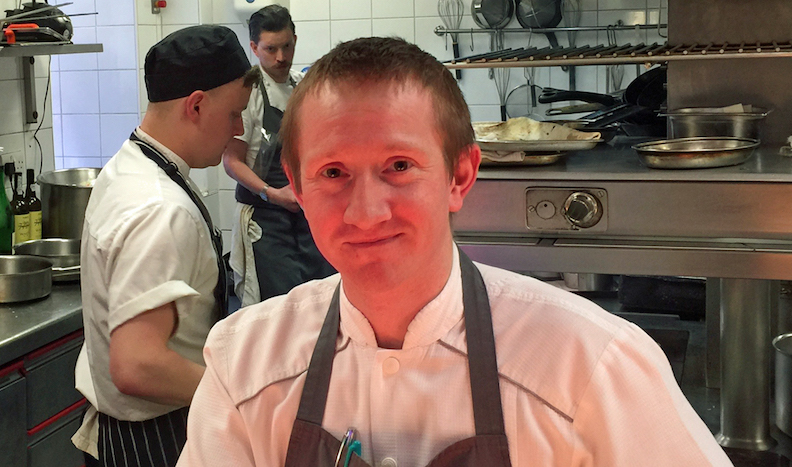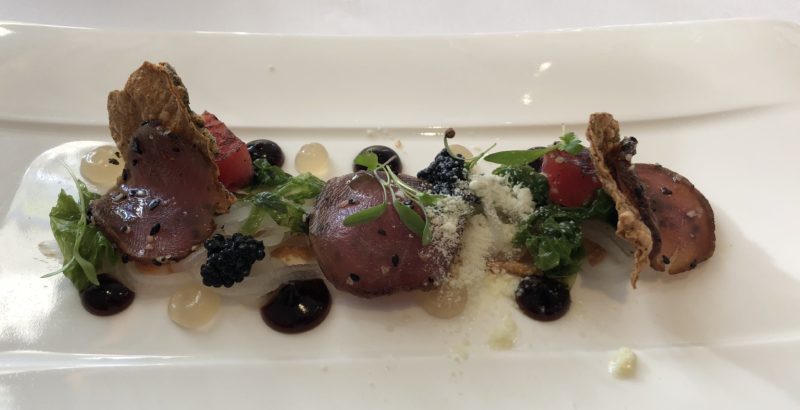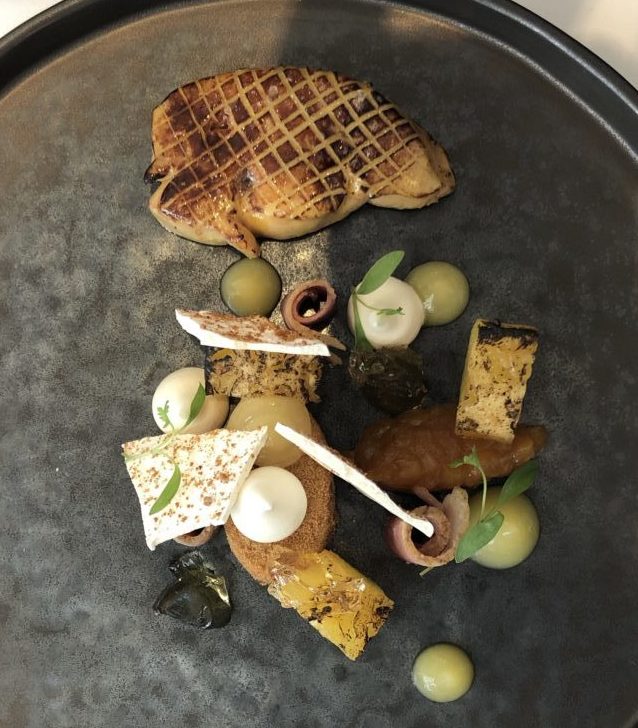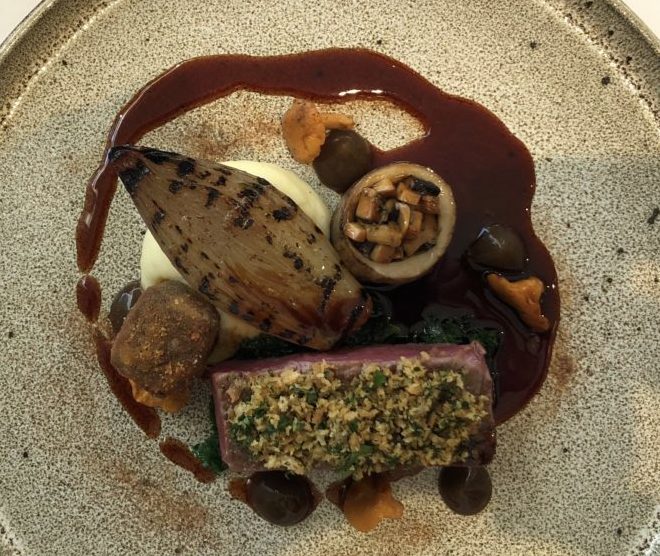This full press release is now made available directly by the AA on their website so this will be the last time that fine dining guide reproduce their press material, in future there will be a link provided via social media to the content.
AA ANNOUNCES NEW MULTI ROSETTE AWARDS. January 22 00.01 2018
UK restaurants awarded with the highest recognition of culinary excellence
The AA has been awarding Rosettes to restaurants since 1956, with the top award of five rosettes being introduced in 1991. The multi rosettes are awarded bi-annually in January and September, with success being determined by one or more visits by an AA inspector to an hotel or restaurant.
Moor Hall Restaurant with Rooms in Ormskirk, Lancashire has been awarded four AA Rosettes, only four months after achieving their third Rosette in September 2017. They are the only restaurant to be awarded this accolade in January’s set of honours.
Stephen Wilkinson, Area Manager at AA Hotel & Hospitality Services said “Moor Hall Restaurant with Rooms has achieved so much in a short space of time. This would not have been possible without the careful planning prior to opening. Mark’s food continues to evolve but the focus has always been on balance and clarity of flavour whilst sourcing the best core ingredients. The team has an impressive kitchen garden which is a key resource for many dishes”.
Eight restaurants have also been awarded three AA Rosettes, including MasterChef: The Professionals judge Monica Galetti and her husband David’s London restaurant, Mere. Restaurants awarded three AA Rosettes are all outstanding restaurants achieving standards that demand national recognition well beyond their local area. Those achieving four AA Rosettes are among the top restaurants in the country. To achieve five AA Rosettes, the restaurants have to reach the pinnacle of the nation’s restaurants where the cooking compares with the best in the world. These restaurants exhibit breathtaking culinary skills, and set the standards to which others aspire, yet few achieve.
Simon Numphud, Managing Director at AA Hotel & Hospitality Services said “We are delighted to recognise these hotels and restaurants for achieving such high standards of culinary excellence which continue to demonstrate the growing strength and depth of British cooking across the country. Our congratulations go to all the dedicated teams within these businesses that have truly earned this level of recognition.
New four AA Rosettes:
Moor Hall Restaurant with Rooms, Ormskirk, Lancashire
New three AA Rosettes:
Benedicts, Norwich, Norfolk
The Burlington Restaurant, Bolton Abbey, North Yorkshire
Carters of Moseley, Birmingham, West Midlands
Jöro Restaurant, Sheffield, South Yorkshire
Mere, London
1851 Restaurant at Peckforton Castle, Peckforton, Cheshire
Samuel’s at Swinton Park, Masham, North Yorkshire
Whatley Manor Hotel and Spa, Malmesbury, Wiltshire
For press enquiries please contact hannah.grimmette@midaspr.co.uk
or call Midas PR on 0207 361 7860
About the restaurants:
Moor Hall Restaurant with Rooms Ormskirk, Lancashire
Imaginative cooking in a boutique bolthole
The ‘restaurant with rooms’ concept at Moor Hall is rather more evolved than the usual traditional approach consisting of a few modest rooms bolted onto a notable eatery. The seven rooms here – as plush as anyone could reasonably ask for – form part of a megabucks boutique transformation of a 16th-century manor into a foodie destination. It comprises a chic restaurant and state-of-the-art open kitchen in a modernist extension, with a soaring raftered roof and glass walls. With all this investment, the culinary draw has to be a biggie, so rest assured that the show stopping cooking of Mark Birchall, whose time at Simon Rogan’s L’Enclume means you will not be disappointed. Expect virtuoso creations built on ingredients that couldn’t be bettered. The drill at dinner is five- and eight-course tasters, opening with home-grown carrots served in multifarious textures with ramsons and sea buckthorn cream, all turbocharged with
Doddington cheese ‘snow’. Next up, crab and turnip broth comes with anise leaves, hyssop and sunflower seed cream. Elsewhere, poached turbot is pointed up with garlic and mussel cream, salsify and sea vegetables, while Westmorland chicken is showcased in another complex workout: the roasted oysters, breast and crispy skin alongside hen-of-the-woods mushrooms, crispy kale, and an offal ragout. Desserts, too, are shot through with creativity: a riff on gingerbread delivers a masterful ice cream with candied parsnips and brown sugar tuiles, and a filo basket of mead-flavoured cream matched with caramelised Bramley apple, sour apple purée and marigold leaves. There’s also a more casual dining venue in a rustic-chic barn.
Benedicts Norwich, Norfolk
Revelatory cooking in the heart of Norwich
Norwich is now firmly established on the UK’s foodie firmament thanks to Benedicts, a switched-on operation where pared-back, Scandi-chic looks tick all the boxes of a big-city venue and make a suitably modernist setting for chef-patron Richard Bainbridge’s innovative contemporary cooking. Devotees of Great British Menu may remember that Bainbridge was the 2015 winner, so diners can be assured of exciting 21st-century food that’s brimful of revelations, courtesy of stimulating combinations of excellent materials.
A starter of moist and super-fresh crisp-skinned mackerel is balanced with bracing bursts of cucumber, sour apple and dill ahead of a main course that sings of spring: hay-baked Blickling Hall Estate hogget matched with spring greens, chervil root and wild garlic. Otherwise, there may be dry-aged Gressingham duck with salted plums, shiitake mushrooms, red onions and thyme sauce. To finish, the nursery comforts of Nanny Bush’s trifle with milk jam passed muster with the exacting standards of the WI ladies on the telly and remains as a signature finisher, or you might go for an equally classic and perfectly rendered lemon tart, its heavenly pastry encasing a zingy lemon custard. It all comes via a seasonal à la carte, six- or eight-course tasting options, or a daily-changing set lunch which offers remarkable value.
The Burlington Restaurant Bolton Abbey, North Yorkshire
Seasonal menus in a lovely setting
The Devonshire Arms may sound like a cosy village pub, but is actually a country house hotel set in 30,000 acres of the Duke of Devonshire’s estate, with a swish spa and a restaurant that has put it well and truly on the gastronomic map. The Burlington Restaurant is the star of the show, where chef Paul Leonard delivers food of craft and creativity, making good use of the estate’s excellent produce (dining during the game season is a good idea) and the kitchen garden for herbs, vegetables and fruits. His dishes are colourful, full of presentational artistry and precisely composed flavours, producing a modern classic pairing of langoustine with succulent pork cheek, alongside Alexanders and celeriac purée. Main-course grass-fed Yorkshire beef is as good as it gets, the meat butter-soft and handled with respect, supported by onions and alliums in various guises, all lifted by smoked bone marrow and a sauce of great depth. The final flourish is a trip back to childhood comforts via an exceptionally light, baked egg custard pointed up with cherries and nutmeg. Superlative nibbles and amuses punctuate the whole experience in imaginative style. Simpler dining is available in the Brasserie, with its roughcast white walls and vibrantly coloured furnishings.
Carters of Moseley Birmingham, West Midlands
Modern British food interpreted with simplicity and skill
The unassuming location amid a parade of shops belies this high-flying neighbourhood restaurant’s ambition. Chef Brad Carter’s operation sticks to the contemporary template of calculated neutral décor, the buzz of an open kitchen, and relaxed, on-the-ball staff whose enthusiasm for the food is palpable. The moreish ‘pigs butter’ (whipped Tamworth pork dripping flavoured with caramelized onions) and splendid home-made sourdough are stalwarts to prime the palate, together with a barrage of on-trend ‘snacks’ – chicken liver cereal, Dorset clam with fermented ramsons, house charcuterie, raw kohlrabi with pine and salad burnet – before an array of bang-on-the-money dishes of inventive and clever pairings. Clarity and freshness define it all, from an opener of deeply flavoursome oat, spelt and barley porridge laden with pine mushrooms (foraged from Lapland) boosted by a broth laced with Moliterno al tartufo (truffled cheese), to top-drawer Skrei cod with leek and buttermilk. Elsewhere, meatier influences come into play. Dry-aged Cornish lamb is pointed up with vivid green wheat grass sauce and bone marrow, or there might be red deer with kabocha squash and quince. The imaginative approach continues through to desserts. For example, an unusual eggless ice cream infused with kombu seaweed and black rice, say, or chocolate ganache finished with dried cardamom, orange zest and minty shiso oil.
Jöro Restaurant Sheffield, South Yorkshire
Classy modern cooking in a shipping container
A converted shipping container off a roundabout on the outskirts of Steel City doesn’t sound too inviting a prospect, but Jöro’s urban edginess is bang in tune with the contemporary trend for neo-Nordic-influenced eating. Inside, the space has a minimalist feel with bare wood floors and tables decorated with flowers and baby vegetables, and the buzz of an open kitchen adding to the convivial vibe.
Despite the urban surrounds, the kitchen team maintains a close bond to nature, working with local farms and foragers to provide a steady flow of seasonal materials – a ‘surprise’ box from one vegetable supplier means the kitchen builds the menus around what turns up that week, and the small plate concept encourages diners to try a salvo of different dishes. Expect pin- sharp techniques and combinations that pack a punch, starting with a perfect piece of mackerel in miso-boosted broth alongside kohlrabi pickled in buttermilk whey, intensely sweet and
smoky wood-fired onions, and roasted yeast purée. Salt-baked celeriac Lincolnshire poacher cheese, black truffle and elder capers is another winning partnership, followed by mallard with red cabbage ketchup and blackcurrant jam. The good ideas flow through to a sweet dish uniting brown butter and muscovado parfait with parkin, apple and Pedro Ximenez jam.
Mere London W1
Smart Fitzrovia joint for a master chef’s first solo venture
Monica Galetti (former Michel Roux Jr/Le Gavroche protégé, though better known to TV audiences as a feared MasterChef: The Professionals judge) has opened her own restaurant with husband David (also a former Gavroche alumni [sommelier], like many of the key staff here). Okay, first up, the name; Mere is pronounced ‘Mary’, being both the French for mother and also Monica’s mother’s name. Next, the location – set at the less frenetic northern end of restaurant-jammed Charlotte Street and certainly adding to its profile. It’s classily understated though; an impressive wooden door immediately shouts sophisticated, grown-up restaurant, and inside doesn’t disappoint. On street level, there’s a smart bar with eye-catching champagne-inspired artwork, while downstairs, the design ramps-up in the unexpectedly light dining room, thanks to its double-height glass frontage and wine-box covered outer wall, allowing pavement light to flood down. As in the bar, there’s a fashionable colour palette of cool blues and greys, but accented here by warming golds, and featuring contemporary Samoan pieces by Monica’s artist cousin.
What really shines is the cooking; contemporary French (classically underpinned, of course) yet sprinkled with touches from Monica’s Western Samoan and Kiwi heritage. The expected consummate skill and attention to detail are obvious, though it comes with a light, refined, yet relatively straightforward approach, backed by flavour and panache. Take an opener of springy tender octopus, with a sweet-sharp tomato reduction and caper condiment, finished with parsley oil, or perhaps a star-turn squab pigeon mains (soft pink roasted breast and crispy skinned leg), with peach (adding a balanced sweetness), girolles and Earl Grey. Desserts might continue with signature ‘banana and coconut’ (cream pie with roasted bananas and rum caramel). Service is informed, professional but relaxed, while the wine list is a corker.
1851 Restaurant at Peckforton Castle Peckforton, Cheshire
Fine cooking in a grand hotel
Peckforton may look like a medieval castle, but the clue to its true vintage lies in the restaurant’s name. Built straight out of the imagination of a wealthy Victorian gent, this mightily imposing building, replete with turrets and crenellations, still does justice to the lofty ambition of its originator. It’s 21st-century incarnation as a hotel and wedding venue features pampering treatments, events, luxe bedrooms and a host of outdoor activities on hand.
The 1851 Restaurant has made the hotel a dining destination, too. The slick and stylish dining room matches the modern thinking in the kitchen, with its sparkling glassware and cutlery and a shimmering wall of wine bottles as you enter. Chef Jason Hodnett has a knack for coaxing out the max from flavours – in a starter of hand-dived scallops partnered with shellfish-packed ravioli and roast leek consommé, or in a main course showcasing wood pigeon – the tender roast breast matched with a confit leg bonbon, beetroot in various colours and textures, sweetcorn granola and purée and the tart-balancing note of blueberry. Another virtuoso workout of flavours and textures closes the show – English strawberries playing the lead role in parfait and consommé form, together with milk sorbet, lavender and sweet herbs.
Samuel’s at Swinton Park Masham, North Yorkshire
Dynamic modern cooking in a glorious country estate
With its baronial tower and castellated walls hung with creeper, Swinton Park makes quite an impression. Within, there’s no let-up in its opulent public areas festooned with antiques and family portraits, and millions have been lavished recently on grafting on a glitzy spa. Samuel’s restaurant is the jewel in its culinary crown, a suitably grand space, with its high gilded ceilings, carved fireplace and views onto the 20,000-acre estate.
Chef Mehdi Amiri celebrates the produce from Swinton’s four acres of walled kitchen garden and the local area, serving delicately herby Swinton Farm trout tartare with dill sorbet and cucumber, or there might be goat’s cheese mousse supported by quail’s eggs, beetroot, orange and hazelnut. Ingredients are of the first order and the kitchen’s technical skill is apparent in main courses: perfectly timed and rested venison (from the estate) comes with chestnut, cabbage, squash and blackberries – there’s even a baby onion filled with confit venison – all pointed up with a rich jus, or immaculately handled roast monkfish matched with black trompette mushrooms, truffled cauliflower gratin, dill pasta and cep beurre blanc. Waiting at the end, an exquisitely crafted dessert involving a spherical white and dark chocolate semifreddo with salted caramel, amaretto, and vanilla yoghurt sorbet.
Whatley Manor Hotel Malmesbury, Wiltshire
Luxury spa hotel cooking
A feeling of anticipation builds as the gated entrance opens into Whatley’s cobbled courtyards of honeystone Cotswold buildings – and that’s as it should be, because the Victorian manor house has long sat in the top flight of the UK’s country house hotels. The principal dining room is an understated modern place, with cream walls, bare floors, and a good measure of space around each table. Niall Keating now leads the kitchen team here, and his blend of refined
contemporary cooking with Asian influences has created a new dining experience. Delivered via a 12-course tasting menu, (including a vegetarian version) phenomenal precision and flavours are there from the off, in a spiced cracker pointed with lime and Parmesan, then the purity of raw oyster with seaweed mignonette dressing. Produce is, naturally, as good as you can get,
and flavours and textures come razor sharp – tempura eel with kimchi aigre-doux, or pigeon with kohlrabi, spiced date purée and wood ear mushrooms, while fish puts in an appearance as halibut supported by charred alliums, pear and shrimp. A trio of desserts offers ideas such as apple with caramel, passionfruit and honeycomb, and wine flights of revelationary pairings line up to enhance the whole experience further.










